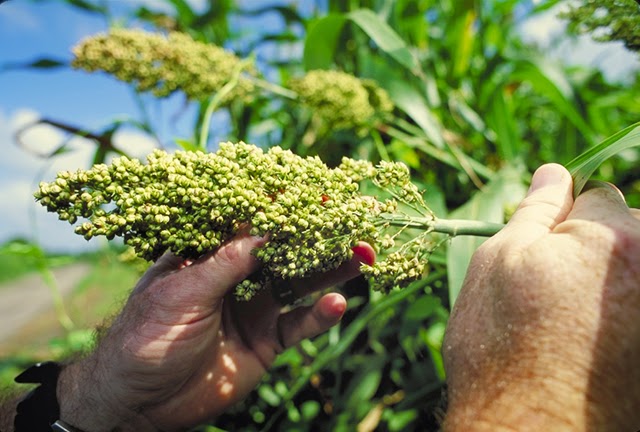Every year farmers plant corn on close to 80 million acres of land throughout the United States. This much-critiqued staple of American agriculture is incredibly resource intensive. To produce 200 bushels, an acre of corn requires 160 pounds of nitrogen and 600,000 gallons of water. And these 'inputs,' as they are called, have consequences, writes Tove Danovich for Civil Eats.
Farmers add nitrogen to the soil in the form of synthetic fertilizer, which tends to run off of Midwestern farm fields and build up in waterways and aquifers. By traveling down the Mississippi to the Gulf of Mexico, this pollution has been a major cause of one of the largest dead zones in the world.
It is for these reasons that some farmers and scientists are pointing to sorghum, also known as milo, as a corn alternative, especially in drought-prone areas. Not only does sorghum seed cost less than corn, but the crop requires less nitrogen too.
An acre of sorghum only needs two-thirds of the water it takes to grow corn and will thrive even when there’s no rain for months — exactly what happened in the 2012 drought.
“The only crop that made it was sorghum,” says Ismail Dweikat of the University of Nebraska-Lincoln’s Agronomy program.
“Corn did not make it. Soybeans did not make it.”
And some farmers, many for the first time, started paying attention to this lesser-known crop.
Although it is primarily used for animal feed or ethanol here in the U.S., sorghum is an important subsistence crop for the large, food-insecure population of sub-Saharan Africa. Both traditional and modern African food uses sorghum and you can find it in recipes for everything from breads and couscous to mass-produced hot cereals.
The hearty crop is better suited to the arid African climate than imports like wheat. But until recently, sorghum has been more or less ignored in other parts of the world.
Now some US food manufacturers are capitalizing on its most marketable trait: sorghum is gluten-free. In the past few years, it has been popping up in spirits, grain mixes, and as a popcorn substitute. While the grassy stalks resemble wheat, the kernel-heavy tops can be as wide as a human hand (even larger in the case of sweet sorghum).
Once a staple sweetener in the Appalachian region of the United States, sweet sorghum is also making a comeback as a syrup that tastes like a cross between maple syrup and molasses.
Read more HERE.
Farmers add nitrogen to the soil in the form of synthetic fertilizer, which tends to run off of Midwestern farm fields and build up in waterways and aquifers. By traveling down the Mississippi to the Gulf of Mexico, this pollution has been a major cause of one of the largest dead zones in the world.
It is for these reasons that some farmers and scientists are pointing to sorghum, also known as milo, as a corn alternative, especially in drought-prone areas. Not only does sorghum seed cost less than corn, but the crop requires less nitrogen too.
An acre of sorghum only needs two-thirds of the water it takes to grow corn and will thrive even when there’s no rain for months — exactly what happened in the 2012 drought.
“The only crop that made it was sorghum,” says Ismail Dweikat of the University of Nebraska-Lincoln’s Agronomy program.
“Corn did not make it. Soybeans did not make it.”
And some farmers, many for the first time, started paying attention to this lesser-known crop.
Although it is primarily used for animal feed or ethanol here in the U.S., sorghum is an important subsistence crop for the large, food-insecure population of sub-Saharan Africa. Both traditional and modern African food uses sorghum and you can find it in recipes for everything from breads and couscous to mass-produced hot cereals.
The hearty crop is better suited to the arid African climate than imports like wheat. But until recently, sorghum has been more or less ignored in other parts of the world.
Now some US food manufacturers are capitalizing on its most marketable trait: sorghum is gluten-free. In the past few years, it has been popping up in spirits, grain mixes, and as a popcorn substitute. While the grassy stalks resemble wheat, the kernel-heavy tops can be as wide as a human hand (even larger in the case of sweet sorghum).
Once a staple sweetener in the Appalachian region of the United States, sweet sorghum is also making a comeback as a syrup that tastes like a cross between maple syrup and molasses.
Read more HERE.
The Global Miller
This blog is maintained by The Global Miller staff and is supported by the magazine GFMT
which is published by Perendale Publishers Limited.
For additional daily news from milling around the world: global-milling.com



No comments:
Post a Comment